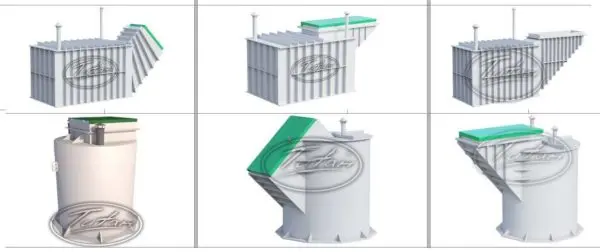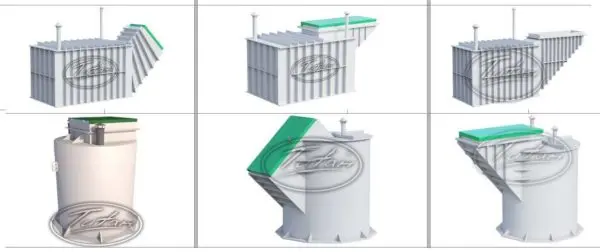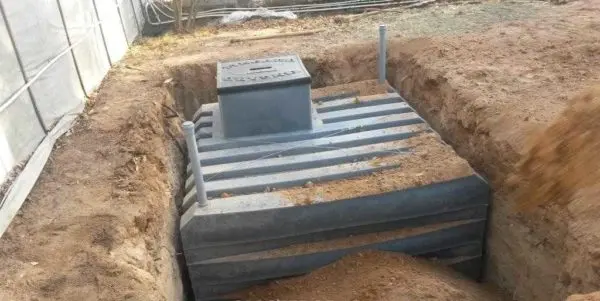Contents
What to do if there is a high level of groundwater on the site, and it is necessary to make storage for products. The output is either a steel welded caisson or a plastic one. In terms of reliability, plastic is more durable, as steel rusts and begins to leak over time.
Caisson – this is a sealed structure, often cylindrical in shape.
Advantages and disadvantages of plastic cellars
When building a cellar from building materials, you have to think about waterproofing – so that groundwater does not get inside. A plastic container is guaranteed to protect against this phenomenon and this is its main advantage. Sellers voiced a long list of pluses, but if you remove the husk, there is not much left besides tightness:
- Plastic is durable, chemically neutral, feels good in soils of any acidity.
- Plastic is not damaged by insects, rodents. This material is simply not interesting to them.
- The walls are easy to wash from dirt of any type.
- If necessary, it is easier to carry out disinfection – spores and bacteria do not “eat” into the walls. If you take everything out of the cellar, plastic surfaces can simply be treated with a solution of chlorine.
- Even if water (condensate, for example) stays for a long time, nothing will happen to the walls / floor.
All this is good, but there are significant drawbacks that limit the use of plastic cellars. Since the container is sealed, a kind of “ship” is obtained. With a high level of groundwater in the spring flood, it can be pushed out / squeezed out. And this is the main problem that we have to deal with. It is solved during installation – you need a whole list of measures that allow you to avoid the ascent of the cellar.
The second major disadvantage is the high price. The cost of a plastic caisson for a cellar is 70-160 thousand rubles without installation. Installation activities can “pull” about the same. If you do everything yourself, it will, of course, be cheaper, but it will still be a lot. So you should think carefully whether you need a plastic cellar or it is better to build a brick / concrete one.
Types and device
A plastic cellar is made using two technologies: welded from sheet plastic or poured in layers. Both methods give almost the same result. When welding, the molten plastic leaves no seams, the surface becomes monolithic. And this is true – there are no complaints about the appearance of leaks in the seams. So there are no special advantages in injection technology. Both there and there, the quality depends on the observance of the technology and the qualifications of the personnel.
The shape of the plastic caisson for the cellar is cubic or cylindrical. The cube is more familiar in the sense that ordinary basements are made square or rectangular. The cylinder – with its rounded structure – is perceived as less comfortable, although this is far from the case. Cylindrical – due to their shape – are less likely to be pushed out.
If you have clay soils and / or a high level of groundwater in your area, it is better to pay attention to a cylindrical plastic cellar. It is more likely to remain in place even after many years, and this despite the fact that the installation is less complicated and cheaper.
Since the container is airtight, ventilation is necessary to maintain normal humidity. For this, in addition to the entrance, two holes are made in the roof for ventilation pipes. The pipes are plastic. One length almost to the bottom of the tank is the inlet. Through it, fresh air enters the caisson. The second – exhaust – ends almost under the ceiling. From there, air is taken in and discharged to the street.
Also, in order to be able to conduct light into the cellar, a small diameter hole is made in the roof – 15-20 mm. A cable is wound through it, after which it is sealed.
Before buying, specify in what form the product will be delivered to you. Many manufacturers immediately put shelves, stairs and their cost is included in the total price. In some models, the shelves are made of plastic and are also stiffeners. Others are equipped with wooden shelves, although the plastic supports are already installed. Some manufacturers offer to sheathe the walls, and if you want, then the floor and ceiling with wooden clapboard. It is difficult to say how reasonable such a design is, but there is a proposal.
What to look for when buying: selection options
Soil and water will press on a plastic cellar buried in the ground. If soils are prone to heaving, during certain periods the pressure is very high, so very stringent requirements are placed on the design.
- The thickness of the walls is selected depending on the “gravity” of the soil.
- If you install a plastic cellar for a summer house or a house in areas with low water levels – they are located at least 0,5 meters below the bottom of the caisson – you can look for a not too expensive option with a wall thickness of about 12-15 mm.
- If, at a low water level, soils also drain water well (sand, sandy loam, peat bogs), containers with a wall thickness of 10 mm are suitable.
- With a high level of groundwater and on heaving soils, thick-walled options with a plastic thickness of about 20 mm are required.
Plastic cellar for home or cottage with welded stiffeners
- Walls, floor, ceiling must have stiffeners. They are cast (ribbed surface) or welded. Smooth walls create less resistance and are easier to push out of the ground.
- For better resistance to compression, the stiffeners can be reinforced with steel rods (for example, POLEX plastic cellars). The second method of reinforcement is an internal steel frame, which is also a support for the shelves. So Tingard solves the problem. Reinforcement of walls and floors is especially important for heaving soils.
Plastic cellar Tingard - Plastic must be food grade. Polyethylene or polystyrene – it doesn’t matter, but food. This is a mandatory requirement if you plan to store more than just jars.
- It is very good if there is an extension on the outside at the bottom of the container – a skirt. This design better resists buoyancy forces.
This is the minimum set of requirements that will ensure the stability of the shape – the walls and the bottom will not bend under the pressure of the soil or heaving forces. In addition, with proper installation, it will be possible to hope that during the flood the caisson will not float.
Installation Rules
Specific recommendations for installation will be given by the manufacturer and they should be given priority when it comes to, for example, a layer of soil that should be on top of the roof. It is also worth listening to the recommendations for backfilling the pit. We will give a general installation scenario, moreover, in relation to the most difficult case: a high level of groundwater paired with heaving soil.
To prevent the plastic cellar from being pushed out under the action of groundwater, a reinforced concrete slab is laid or cast at the bottom of the pit. The thickness of the slab is 20 cm, the dimensions should be at least 15-20 cm larger than the dimensions of the container. When self-filling, a double frame of reinforcement is knitted (12 mm or less) as when pouring a slab foundation. If you make the slab yourself, you must wait at least 2 weeks until the concrete gains enough strength. Then you can continue working.
The procedure for installing a plastic cellar is as follows:
- Dig a pit, the depth of which is at least 40 cm more than the height of the container to the edge of the neck. Align the bottom, tamp (preferably with a tamping machine, if not – you can just mechanically – with a deck with attached handles and a plate on the bottom.
- Lay a layer of geotextile with a density of 200 g/m2. The canvas should be larger than the size of the pit by 50 cm on each side.
- Lay 20 cm of gravel on the geotextile, level it.
- Lay or cast the slab. To make the plate more stable, we use longer reinforcement when knitting the frame. We do with releases – it can reach the walls of the pit. When casting the slab, do not forget to cast in place the studs or other fasteners to fix the caisson. These studs/hooks must be stainless steel.
Laying the slab is faster than doing it on the spot - A plastic cellar is placed on the finished slab for a summer residence or a house, fixed to the slab with stainless steel ropes or plastic slings.
- Thermal insulation of walls. To maintain a positive temperature inside the cellar in cold weather, the walls must be overlaid with thermal insulation. It is better to lay extruded polystyrene foam in the ground. Thickness – 50 mm. To what depth? 10-20 cm below the freezing depth.
- Backfilling of the pit. Before backfilling, fold the geotextile, lay the fold on the slab. You can secure it with something so it doesn’t roll back. And here are the options:
- Some manufacturers require concrete pouring, and even reinforcing walls in two rows. It will, of course, be reliable and nothing will come up, the walls will not bend. But why then a plastic caisson? Only for waterproofing? So with mastic for pools, you can smear concrete walls and achieve the same result, and the cost of waterproofing will be 10-20 times less, even if you take very expensive compounds and apply them in several layers.

What is the plastic container for in this scenario? - It may be necessary to backfill with concrete mix. In certain proportions (indicated by the manufacturer), building sand and concrete are mixed. This mixture fills the space between the cellar wall and the pit. When filling, the mixture is well compacted. When it rains, this mixture will gradually turn into concrete. So this is one of the subspecies of concreting.
- Backfilling with sand or gravel. In this embodiment, the backfill will act as a damper for the forces of frost heaving. But a looser aggregate will contribute to the fact that water will collect here. Since plastic does not react with water in any way and is not afraid of it, this option is possible.
- Backfilling with “native” soil. These recommendations are given by manufacturers who are confident in their product. Nothing prevents falling asleep with sand or gravel.

You can fill the gap between the walls of the pit and the caisson with native soil
- Some manufacturers require concrete pouring, and even reinforcing walls in two rows. It will, of course, be reliable and nothing will come up, the walls will not bend. But why then a plastic caisson? Only for waterproofing? So with mastic for pools, you can smear concrete walls and achieve the same result, and the cost of waterproofing will be 10-20 times less, even if you take very expensive compounds and apply them in several layers.
- Top insulation. It is advisable to lay the insulation not only above the container, but also capturing 1-1,5 meters to the sides. This is a guarantee that frost will not settle on the roof in winter and moisture will not condense in summer. Insulation – extruded polystyrene foam 50 mm thick. Lay in two layers with spaced seams.
- Filling the slab or backfilling with soil. The stove is poured if the GWL is very high. Additional load is only a plus. You can fill it with soil if the situation is not so deplorable.
As you can see, the installation is quite complicated, but this is for the “hard” case – high groundwater and clay or loam. Although, such conditions are a reality for most regions of our country.
Stairs and entrance
Usually a vertical ladder is placed in a plastic cellar – metal or plastic. It is far from convenient to use. It is still normal for young people, but it is very difficult for older people. In addition, imagine how you will lower / raise bags of potatoes, carrots, beets. Banks are no better. How to raise or lower them so as not to break. Okay, for cargo, you can think of something. For example, to make the simplest lift: block, rope, basket. Load supplies into baskets and lower them in this way. Partially the problem is solved, but going up and down the steep stairs is an unsolvable problem.

It is much more convenient if the ladder is placed at an angle, but in this case a neck is needed for almost the entire length of the body. In most cases, the caisson for the plastic case is made to order. When ordering, you can ask if they can make a large neck. It shouldn’t affect durability. The only possible consequence is that the mass that presses the caisson from above will decrease, saving it from being pushed out. The way out is to make the plate a little thicker on top.
There is another option. Some manufacturers (Titan) have developed models of plastic cellars with an inclined entrance. They are, of course, much more convenient to use, but more difficult to install. And the price is even higher.











